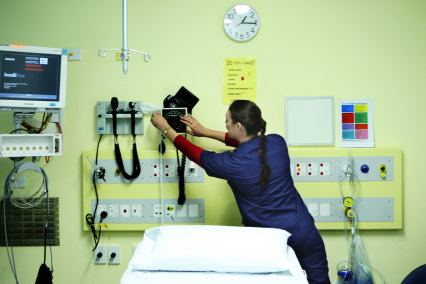This was published 2 years ago
Opinion
Healthcare workers must be treated with care in wake of COVID burnout
By Sue Dean and Deb Massey
The toll of COVID-19 on our healthcare workers has been brutal, with many saying they want to quit their jobs.
The World Health Organisation says burnout, coupled with an ageing workforce, is a “ticking time bomb” that could lead to “poor health outcomes across the board, long waiting times for treatment, many preventable deaths, and potentially even health system collapse”.
The Royal Australian College of General Practitioners’ just published an annual survey that reported some three-quarters of GPs say they feel burnt out.
With burnout characterised in part by a “depersonalisation” or a sense of detachment, it can be tough to care for others. “Compassion fatigue” can set in. So, how can we help health workers to continue helping others?

COVID-19 has led to an increase in burnout in health workers.Credit: iStock
A worldwide workforce shortage
Workforce projections predict health workforce shortages worldwide. Retention is a major factor and burnout the major contributor. During the pandemic, studies from the United States and Singapore reported unprecedented turnover in the healthcare sector, and again burnout was the biggest factor.
In Australia, a report found that during the first wave of COVID-19, nurses experienced high rates of anxiety and depression. COVID-19 disruptions meant less access to social supports. Less social support affects a person’s ability to cope.
Workplace culture was seen as negative. There were safety concerns about working with patients with COVID. A fear of transmitting the virus to their families and friends led to increased anxiety. There was inadequate, inappropriate and often limited or unavailable personal protective equipment (PPE) for healthcare workers and carers. When it was available, workers felt PPE and physical distancing constraints prevented them providing the compassionate care required.
Healthcare workers experienced increased violence and aggression from patients and the public when enforcing government-mandated restrictions. They also faced significant increases in workloads.
New models of care were introduced, often with little preparation or training. Staff shortages resulted from COVID isolation, and staff were redeployed to areas of high need in healthcare, which left shortages in other areas.
Healthcare workers also identified a lack of support from leadership and organisational culture compromised their psychological safety.
Burnout and clinical mistakes
The Australian Medical Association reports that almost half of the junior doctors in New South Wales are overworked and exhausted, and burnout could be putting patients at risk. Of 1766 doctors surveyed, 76 per cent reported making a fatigue-induced clinical error.
A US study reported increases in physician burnout were associated with increased medical errors and worse patient outcomes.
And an international study has revealed that nurses report “missed care”, “care at improper times” and “unfulfilled care” due to excessive job demands.

Australian healthcare workers have complained about burnout during the pandemic.Credit: Peter Braig
When caring for others is too much
“Compassion fatigue” means healthcare workers are unable to carry out their roles. Compassion fatigue can result from repeated exposure to others’ suffering in high-stress environments and the constant giving of self.
It leads to complete physical and emotional exhaustion, depleting healthcare workers of their ability to cope. Crucially, it disconnects them from their patients, making them unable to be empathetic and provide compassionate care. Usual coping strategies aren’t effective and negative coping strategies such as alcohol or substance abuse can follow. Ultimately, workers feel a diminished sense of satisfaction in their work and burnt out.
Healthcare workers can mitigate against compassion fatigue by making time for themselves, enforcing work boundaries, and creating a better work-life balance.
Strategies such as mindfulness meditation have been shown to be effective. So have employer support programs such as counselling services and advocating for organisations to provide healthy and nurturing workplaces.
Rejecting the health hero narrative
Compassion fatigue and burnout also occur when healthcare workers are not valued.
During the pandemic, healthcare workers have been increasingly portrayed as angels and heroes, who appear to be able to swoop in and save the day. Nurses and other healthcare workers have argued that this narrative is outdated and fails to recognise their complex roles.
Instead of being given hero status, nurses and other healthcare workers are seeking opportunities to highlight the complex skills and compassion required to undertake their roles. This could prove transformative for media reports, fictional portrayals of doctors and nurses on screen, and even how hospitals and health centres represent healthcare workers in recruitment and retention campaigns.
A time to re-evaluate
The pandemic has brought the predicted shortages in the healthcare workforce into sharp focus. The role of burnout and compassion fatigue are important factors.
While resilience is a key protective factor – and one that healthcare workers are encouraged to develop – it isn’t enough. Healthcare leaders have an ethical and legal obligation to ensure all workers have access to work environments that are psychologically safe and free from violence and aggression. And health needs to be adequately resourced so that patient care is prioritised and workloads are safe.
After all, if we don’t care for our health workforce, who will care for us?
Sue Dean is a lead lecturer practitioner in nursing at the faculty of health at Southern Cross University and Deb Massey is an associate professor in the faculty of health’s school of nursing at Southern Cross University.
This article is republished from The Conversation under a Creative Commons license. Read the original article.